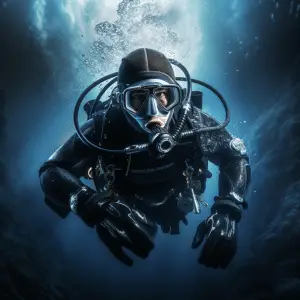Scuba diving is an amazing way to explore the underwater world. But, what should you wear? It’s important to wear the right clothes to stay safe and comfortable.
The most important item is a neoprene wetsuit. Choose a thicker one for cold water and a thinner one if it’s warm. Additionally, you’ll need a dive mask and snorkel. These tools make it easy to see and breathe.
Don’t forget dive boots or booties. They provide protection and warmth. Some locations and activities may require gloves, hoods, or specialized suits, like drysuits or semi-dry suits.
Before your dive, try on your gear and make sure everything fits properly. After all, the only thing worse than seeing a shark is a fashion disaster!
Importance of Choosing the Right Attire for Scuba Diving

Choosing the right gear for scuba diving is important. It keeps you safe and enhances your performance. Here’s what to consider when selecting attire:
- Make sure you get a wetsuit or drysuit that fits well. This prevents water from entering and maintains body temperature while you dive. A neoprene wetsuit keeps you warm in cold water, while a drysuit keeps you completely dry – perfect for colder temperatures.
- Pick a suit thickness based on the water temperature. Thicker suits are better for colder conditions. Thinner ones give you more flexibility in warmer waters. So match the suit thickness to the dive location’s climate.
- Wear dive boots or booties to protect your feet and ankles from sharp objects or rough terrain. Make sure they fit snugly, but don’t restrict movement.
- Exposure protection is important. Consider gloves and hoods if diving in chilly waters. This helps keep body heat in, and water out.
- Masks and snorkels are great for visibility. Opt for a mask with a snug seal so you can see clearly underwater, without leaks. A snorkel helps you conserve energy by breathing at the surface.
By choosing the right scuba diving attire, you can ensure comfort and safety underwater. Properly fitting gear is key for keeping body heat in, and hazardous conditions out.
Safety Considerations for Scuba Diving Attire
Scuba diving is an exciting escapade, and it’s important to be mindful of safety when it comes to apparel. Consider these factors:
- Ensure proper fit: Wear a wetsuit or drysuit that fits snugly.
- Choose the right material: Opt for suits made from neoprene.
- Prioritize visibility: Bright colors or reflective dive attire can prevent collisions.
- Check for durability: Get high-quality materials that will last.
- Protect extremities: Don’t forget gloves, boots, and hoods.
Wearing a hood can keep you warm and reduce heat loss. Fun fact: PADI says 8 million people are certified scuba divers!
It’s like choosing between LBDs and onesies – find the perfect fit for the occasion!
Different Types of Diving Suits
Diving suits come in many different types, let’s explore the options for scuba divers! Check out the table below for a quick overview.
| Diving Suit Type | Thickness (mm) | Key Features |
|---|---|---|
| Wetsuit | 2-7 | Thermal insulation and flexibility |
| Drysuit | 5-8 | Keeps the diver dry by sealing out water |
| Semi-dry wetsuit | 5-7 | Combines elements of both wetsuits and drysuits |
| Dive skin | N/A | Minimal warmth and protection |
Wetsuits typically range from 2 to 7 mm. They provide thermal insulation and flexibility for warm water dives. They trap a thin layer of water between the suit and the diver’s body, which is warmed by body heat.
Drysuits are great for cold-water dives. With thicknesses ranging from 5 to 8 mm, these suits keep divers dry by creating a watertight seal. Seals around the neck, wrists, and ankles block water. Undergarments can be worn for extra insulation depending on the diving conditions.
Semi-dry wetsuits offer warmth and flexibility. They have additional seals to reduce water flow.
Dive skins are lightweight suits that offer minimal warmth and protection. They are used for warm-water diving and as an extra layer under wetsuits for protection against stinging marine life and abrasions.
Pro Tip: Choose the right diving suit based on the water temperature and conditions for comfort and safety. Diving suits should fit snugly, keep you warm, and never let you down – like your ex!
Factors to Consider When Choosing Diving Suits
Scuba diving is an amazing experience, but it needs the right gear for safety and comfort while underwater. Let’s explore the factors to consider when picking diving suits.
- Material: Neoprene – flexible and insulating.
- Thickness: 3mm-7mm, depending on water temp and preference.
- Fit: Tight but comfy – too loose can create drag or restrict movement.
- Zipper Type: Back or Front Zip – personal preference, but front is easier to don/doff.
Also, look for extra features like reinforced knees, hoods for warmth, and seals at wrists and ankles.
Tip: Try on many suits before making a purchase for the best fit.
Choose the perfect diving suit – essential for a successful and enjoyable dive. Consider all the factors and make an informed decision!
Time to gear up and explore the depths – let’s dive in and find the right equipment!
Additional Gear and Equipment for Scuba Diving
For a safe and enjoyable dive, you’ll need some extra gear. Here’s what you need to know:
- Dive mask: For clear underwater vision.
- Wetsuit/Drysuit: To keep you warm in cold water.
- BCD: To help you control buoyancy.
- Regulator: To deliver air and let you breathe.
Now, let’s look at more essential items:
- Dive computer: Displays dive time, depth, and decompression limits.
- Dive fins: For better mobility underwater.
- Weight system: For neutral buoyancy.
- Mask defogger & snorkel keeper: To keep your vision clear and hold your snorkel.
Additionally, consider these special details:
- Knife/cutting tool: In case of entanglement or repair.
- SMB: To signal your location to boats.
- Dive light: For dark spots and night dives.
- Spare parts and O-rings: In case of malfunction.
Did you know? During WWII, Jacques-Yves Cousteau and Emile Gagnan developed the Aqua-Lung regulator. This changed diving forever, allowing divers greater freedom. Since then, advances in material, design, and tech have increased scuba diver safety and comfort.
Remember to take care of your gear, or you might end up feeling like a soggy Captain Hook!
Tips for Care and Maintenance of Scuba Diving Attire

Scuba diving is an exciting activity that needs proper care and maintenance of your gear for safety and long life. Here are a few helpful tips on taking care of your scuba attire:
- Rinse your gear with fresh water after every dive. This helps get rid of salt and other stuff which can cause harm or corrosion.
- Hang your wetsuit or drysuit in a ventilated spot to dry before you store it. Avoid putting it in direct sunlight since it can weaken the fabric.
- Check zippers, valves and seals regularly for any signs of wear or damage. Replace any faulty pieces right away to avoid leaks.
- Store your gear in a cool, dry area away from the sun and extreme temperatures. Good storage will stop mold growth and increase the life of your equipment.
- Do regular maintenance on your BCD (Buoyancy Control Device) by cleaning and greasing the inflator valves and connections. This makes sure it works properly during dives.
Also, certain details can make a difference in the life of your scuba attire. For example, use a mild detergent made for neoprene when cleaning your wetsuit or drysuit. This helps keep its elasticity and strength. Plus, keeping your fins upright with the foot pocket straight will reduce tension on the fin blade.
Pro Tip: When storing your scuba mask, put it in a hard case to protect the lenses from scratches and damage. Following these care and maintenance tips will make sure your scuba diving gear is in perfect condition for many underwater trips! Don’t limit yourself – get creative and make a statement with your scuba gear!
Conclusion
Scuba diving? Get the right gear! Comfort and protection? Yes, please. Wear a wetsuit, fins, a mask, and snorkel for a successful dive. Gloves and boots? They’ll give extra protection against sharp objects and keep you warm in cold waters. And don’t forget a BCD and an exposure suit suitable for the water temp. Follow these guidelines and you’ll have an amazing scuba diving experience.
Pro Tip: Get advice from experts or experienced divers before buying any scuba gear. They’ll help you choose the right equipment.
Frequently Asked Questions
Q: What should I wear when scuba diving?
A: When scuba diving, it is recommended to wear a wetsuit or a drysuit, depending on the water temperature. This will provide insulation and protection against scrapes and stings.
Q: Can I wear a swimsuit while scuba diving?
A: While it is possible to wear a swimsuit while scuba diving in warm waters, it does not provide sufficient insulation or protection. It is best to opt for a wetsuit or a drysuit for safety and comfort.
Q: What should I wear on my feet when scuba diving?
A: You should wear neoprene booties or dive socks, which provide warmth, protection, and grip. These are essential to protect your feet, particularly in rocky or sandy areas.
Q: Do I need to wear gloves when scuba diving?
A: Wearing gloves while scuba diving is a personal choice. Gloves can provide warmth and protect against cuts or scrapes, but they may reduce dexterity. It is important to choose the right gloves based on the water temperature and your needs.
Q: Should I wear a hood when scuba diving?
A: Wearing a hood is recommended in colder waters to prevent heat loss from the head. It also provides protection against sunburn and scrapes. However, in warmer waters, a hood may not be necessary.
Q: Are there any specific clothing recommendations for female scuba divers?
A: Female scuba divers can choose to wear wetsuits or drysuits designed specifically for women. These provide a better fit and comfort. Additionally, wearing a supportive sports bra under the wetsuit can enhance comfort and ease movement.
